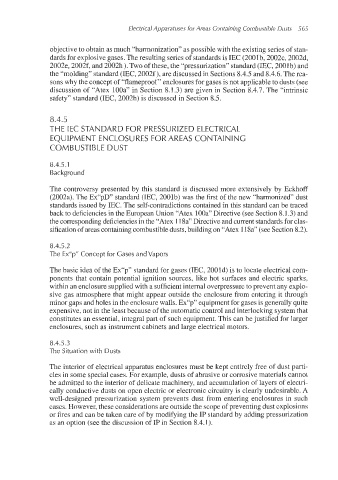Page 598 - Dust Explosions in the Process Industries
P. 598
Electrical Apparatuses for Areas Containing Combustible Dusts 565
objective to obtain as much “harmonization”as possible with the existing series of stan-
dards for explosivegases. The resulting series of standardsis IEC (2001b, 2002c, 2002d,
2002e, 2002f, and 2002h). Two of these, the “pressurization”standard (IEC, 2001b) and
the “molding” standard (IEC, 2002f), are discussed in Sections 8.4.5 and 8.4.6. The rea-
sons why the concept of “flameproof”enclosuresfor gases is not applicable to dusts (see
discussion of “Atex lOOa” in Section 8.1.3) are given in Section 8.4.7. The “intrinsic
safety” standard (IEC, 2002h) is discussed in Section 8.5.
8.4.5
THE IEC STANDARD FOR PRESSURIZED ELECTRICAL
EQUIPMENT ENCLOSURES FOR AREAS CONTAINING
COMBUSTlB LE DUST
8.4.5.1
Background
The controversy presented by this standard is discussed more extensively by Eckhoff
(2002a). The Ex“pD’ standard (IEC, 2001b) was the first of the new “harmonized” dust
standards issued by IEC. The self-contradictionscontained in th~sstandard can be traced
back to deficiencies in the European Union “Atex 100a”Directive (see Section 8.1.3) and
the correspondingdeficiencies in the “Atex 118a”Directiveand current standards for clas-
sificationof areas containingcombustibledusts,building on “Atex 1lSa” (see Section8.2).
8.4.5.2
The Ex“p“ Concept for Gases and Vapors
The basic idea of the Ex“p” standard for gases (IEC, 2001d) is to locate electrical com-
ponents that contain potential ignition sources, like hot surfaces and electric sparks,
within an enclosuresupplied with a sufficientinternal overpressure to prevent any explo-
sive gas atmosphere that might appear outside the enclosure from entering it through
minor gaps and holes in the enclosure walls. Ex“p” equipment for gases is generally quite
expensive, not in the least because of the automaticcontrol and interlocking systemthat
constitutes an essential, integral part of such equipment.This can be justified for larger
enclosures, such as instrument cabinets and large electrical motors.
8.4.5.3
The Situation with Dusts
The interior of electrical apparatus enclosures must be kept entirely free of dust parti-
cles in some special cases. For example, dusts of abrasive or corrosive materials cannot
be admitted to the interior of delicate machinery, and accumulation of layers of electri-
cally conductive dusts on open electric or electronic circuitry is clearly undesirable. A
well-designed pressurization system prevents dust from entering enclosures in such
cases. However, these considerationsare outside the scope of preventing dust explosions
or fires and can be taken care of by modifying the IP standard by adding pressurization
as an option (see the discussion of IP in Section 8.4.1).

